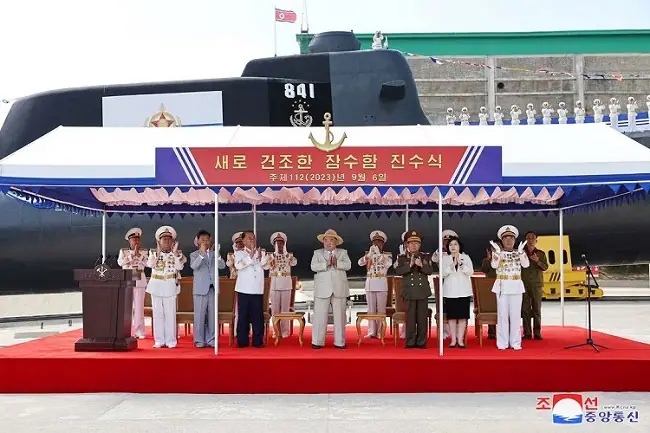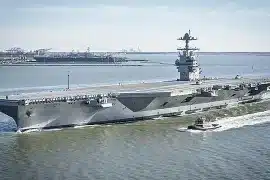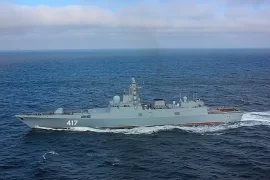North Korea’s submarine fleet has long been shrouded in secrecy and intrigue, making it a subject of fascination and concern for military analysts and policymakers worldwide. While the regime’s focus on its nuclear missile program often takes center stage, the role of submarines in North Korea’s military strategy should not be underestimated. In this comprehensive article, we delve into the enigmatic world of North Korea’s submarine fleet, exploring its history, capabilities, and potential implications for regional and global security.
A Varied Fleet
North Korea’s submarine fleet comprises a diverse range of vessels, with varying sizes, capabilities, and roles. At the forefront of this fleet are the Soviet-era Romeo-class submarines, 7 of which they got from China in the 1970s. North Korea later produced the vessels domestically from 1976 until 1995. These diesel-electric submarines are obsolete by modern standards, and many countries use them primarily for training purposes. However, North Korea has adapted and maintained its Romeo-class submarines, relying on their stealthy nature when submerged.
In 1990, North Korea achieved vertical launch technology by acquiring 3 scrapped Golf-class submarines from the Soviet Union.
In 1995, North Korea shifted to the production of Sang-O-class submarines. These are basically coastal submarines. Currently, North Korea’s submarine fleet has around 40 Sang-O and Sang-O II-class coastal submarines.
North Korea’s submarine fleet comprises an estimated total of 85 submarines, categorized as follows:
Ballistic Missile Submarines (SSBNs): 2
Nuclear-armed attack submarines: 1
Air-independent propulsion (AIP) enabled: 1
Coastal Submarines (SSCs): 40
Conventional Submarines (SS): 20
Mini Submarines (SSMs): 21
The Korean People’s Navy (KPN) primarily operates the submarines, although certain assets come under the jurisdiction of North Korea’s primary foreign intelligence agency, known as the Reconnaissance General Bureau (RGB).
Modernization Efforts
In recent years, North Korea has displayed its determination to modernize its submarine capabilities. Analysts first spotted signs of new submarine construction in 2016, indicating a commitment to expanding its underwater arsenal. In 2019, state media showcased North Korean leader Kim Jong-un inspecting a previously undisclosed submarine. This marked a significant development, as it demonstrated Kim’s “special attention” to the new vessel, hinting at its potential importance within the country’s military strategy.
North Korea’s Nuclear Attack Submarine
On September 6, North Korea unveiled a nuclear attack submarine to mark the 75th anniversary of its founding day.

The submarine (no.841) is named after North Korean naval hero Kim Kon Ok. The Hero Kim Kun Ok submarine is based on the aging Soviet-era Romeo-class model. It has ten launch tube hatches. The submarine will short-range submarine-launched cruise missiles (SLCM).
Missile Capabilities
The most striking aspect of North Korea’s submarine fleet is its potential to carry and launch missiles. While specifics regarding the fleet’s missile capabilities remain closely guarded secrets, the international community became acutely aware of this potential when the experimental ballistic missile submarine 8.24 Yongung (August 24th Hero) fired a missile. This event underscored North Korea’s ambition to develop submarines capable of carrying and launching missiles, significantly increasing the security concerns in the region.
Regional and Global Implications
North Korea’s submarine fleet poses various security challenges, both regionally and globally. On a regional scale, the stealthy nature of these submarines makes them effective tools for covert operations, reconnaissance, and potential surprise attacks. Their ability to carry missiles capable of striking neighboring countries like South Korea and Japan raises alarm and necessitates constant vigilance. Moreover, North Korea’s nuclear attack submarine can be a threat to the US presence in the region and its allies South Korea and Japan.
North Korea’s submarine activities have been a source of tension on the Korean Peninsula for decades. Between the 1990s and 2010, North Korea faced losses of submarines and semi-submersibles while attempting espionage and infiltration into the South. Notable incidents include a Sang-O-class submarine running aground in 1996, leading to a dramatic manhunt and casualties. In 1998, a Yugo-class submarine became entangled in South Korean waters, resulting in crewmembers’ tragic deaths. A mini-submarine narrowly escaped capture near Ganghwa Island, causing embarrassment to North Korea. The most significant incident occurred in 2010 when the South Korean corvette ROKS Cheonan was sunk, likely by a North Korean mini-submarine, escalating tensions further. North Korea’s involvement remains disputed, adding to the complexities of regional security.
International Response
The international community, led by the United Nations, has imposed strict sanctions on North Korea to curb its nuclear and missile ambitions, including any related to its submarine fleet. However, the regime’s ability to adapt and circumvent sanctions has proved time and again, making it challenging to completely curtail its submarine modernization efforts.
Summary of North Korea’s Submarine Fleet
North Korea’s submarine fleet remains an enigmatic force with evolving capabilities. While it includes aging vessels that are obsolete by modern standards, recent developments indicate the regime’s determination to modernize its underwater arsenal. The potential for submarines to carry and launch missiles has profound implications for regional and global security. As tensions in the region continue to ebb and flow, monitoring North Korea’s submarine fleet remains essential for assessing potential security risks and working toward regional stability. The world watches closely as the regime balances obsolescence with ambition in its quest for maritime power.







